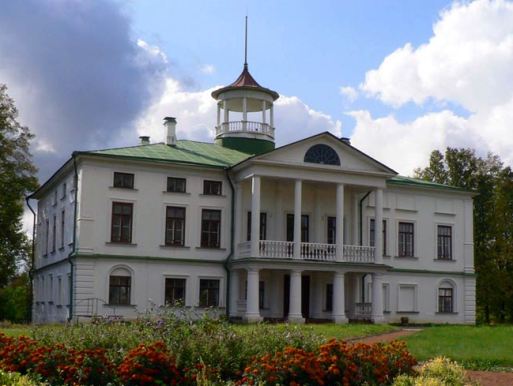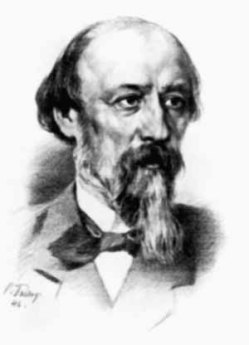


Nestled in the Yaroslavl Oblast of Russia, approximately 15
kilometers south of Yaroslavl's city center, the quaint village of
Karabikha is most celebrated for its historic estate, now operating
as the State Literary-Memorial Museum-Reserve honoring the eminent
Russian poet Nikolai Alekseevich Nekrasov. This estate, often called
the Nekrasov Museum-Estate or Karabikha Palace, exemplifies classic
18th- and 19th-century Russian aristocratic architecture and
landscape design. It provides an immersive glimpse into Russia's
rich literary legacy, the opulent lifestyle of the nobility, and the
inspirational backdrop for Nekrasov's poetic endeavors. Designated
as a federal cultural heritage site, it remains one of the rare
fully preserved noble estates in the Yaroslavl region, having
endured revolutions, conflicts, and eras of abandonment.
The
estate's prominence largely derives from its connection to Nekrasov,
who utilized it as a seasonal haven from 1861 until 1875. In these
years, he penned iconic pieces such as "Russian Women," "Frost, Red
Nose," "Grandfather Mazai and the Hares," and segments of his magnum
opus "Who Lives Well in Russia." Founded in 1946, the museum
safeguards over 20,000 artifacts tied to Nekrasov, the estate's
evolution, and everyday 19th-century Russian existence, positioning
it as an essential stop for literary aficionados, historians, and
travelers traversing Russia's Golden Ring.
The roots of the Karabikha estate extend to the early 18th century,
when the lands—originally near the village of Bogorodskoye, later
rechristened Karabikha—were procured by the illustrious Golitsyn family.
Initial construction occurred in the 1720s and 1730s under Prince
Nikolai Sergeevich Golitsyn, starting as a wooden manor atop
Karabitovaya Gora (Karabikha Hill). By the 1740s, it transitioned to a
stone structure, emerging as the grandest estate in the Yaroslavl
province. Though the architect is unidentified, the design embodies the
prevailing classicism style in Russian architecture of that period.
In the early 1800s, Prince Mikhail Nikolaevich Golitsyn spearheaded a
comprehensive overhaul, sculpting the estate into its present
palace-like form. Following his passing in 1827, the property
deteriorated under subsequent heirs. Nekrasov acquired it from the
Golitsyns in 1861, primarily as a summer sanctuary, and deeded it to his
brother Fyodor, who oversaw daily operations. Nikolai visited each year
from May to September, drawing profound inspiration from the pastoral
surroundings to craft verses addressing peasant hardships, societal
inequities, and folk traditions. His son Konstantin was born here, and
Nekrasov persisted in his sojourns until 1875, when terminal illness
(cancer) anchored him in St. Petersburg. After Nekrasov's demise in
1877, Fyodor stewarded the estate until the Bolshevik Revolution.
Post-1917 nationalization transformed it into a state farm under Soviet
rule. Its endurance owes much to Nekrasov's image as a poet championing
the proletariat, resonating with communist ideology. In 1946, it became
a museum affiliate of the Yaroslavl Regional Museum, with meticulous
restorations upholding its authenticity. Achieving independent
museum-reserve status in 1988, it expanded to include affiliates in
Greshnevo (Nekrasov's birthplace) and Abbakumtsevo. Presently, it
symbolizes Russia's architectural and literary heritage, with preserved
ruins like the greenhouse and wine warehouse also classified as federal
monuments.
Nekrasov's biography enriches the estate's narrative.
Shaped by his mother's ordeals in a dysfunctional family, these
experiences infused his writings. His non-traditional union with Zinaida
Nikolaevna (née Fekla Anisimovna Viktorova), whom he mentored and
cohabited with sans matrimony, features prominently in guided
narratives. Beyond poetry, Nekrasov was a fervent hunter and astute
publisher of Sovremennik, showcasing talents like Tolstoy and
Dostoevsky.
Karabikha exemplifies classicism architecture in a palace complex,
anchored by a two-story stone principal residence (the Big House) with
flanking wings once linked by covered passages (now dismantled). Notable
elements include column-supported gables, expansive verandas, a
picturesque gazebo, and a terraced slope to the Kotorosl River.
Interiors preserve late 18th- and early 19th-century flourishes, such as
ornate baroque frames and arched windows. The equestrian courtyard, from
the early 19th century, boasts a balanced arrangement with a central
structure and coach houses (one reconstructed in the early 20th
century). A network of ponds and ancillary buildings rounds out the
layout.
The expansive grounds feature two contrasting parks,
highlighting diverse horticultural approaches. The Upper Park, beside
the main house, adheres to formal French garden principles with clipped
hedges, aligned trees, and allocated spaces for statuary and decor.
Conversely, the Lower Park adopts an English romantic style—seemingly
wild yet artfully orchestrated with strategic plantings. The Gremikha
cascade, a stream channeling through sequential ponds to form
waterfalls, bridges the parks. In the Lower Park's meadow, Nekrasov
conducted renowned poetry sessions. Additional orchards, floral beds,
and water features burst with color in spring and autumn. While largely
intact, some sections exhibit wear, including eroded walkways, rugged
terrain, and sporadic overgrowth, with the greenhouse and wine warehouse
ruins enhancing its timeless allure.
As the N.A. Nekrasov State Literary-Memorial Museum-Reserve,
Karabikha curates an extensive array of over 20,000 items, encompassing
antique furniture, personal relics, artworks, and archival materials.
Highlights include late 19th- and early 20th-century amateur photos, a
library exceeding 15,000 rare volumes and periodicals (featuring
Nekrasov's first editions and seven from his collection), 19th-century
crystalware, and documents like an 1808 correspondence from A.I.
Musin-Pushkin to M.N. Golitsyn. The Eastern Wing houses recreated
memorial chambers based on historical photos and testimonies, evoking
late 19th-century domesticity.
The museum's cultural weight stems
from its status as a literary sanctuary. Nekrasov's residency here
birthed works decrying serfdom and extolling Russian fortitude,
impacting subsequent authors profoundly. Tours and displays explore his
life story, artistic methodology, familial ties, and historical milieu,
including maternal influences and publishing triumphs. Rotating exhibits
and programs, such as the yearly "Nekrasov Days" (around his December
birthday) and scholarly forums like "Karabikha Scientific Readings,"
maintain vibrancy. In 2025, notable events encompass the 58th
All-Russian Nekrasov Poetry Festival on July 5, "Nekrasov Days 2025"
from December 1-10 (commencing today, as of December 1, 2025), and the
theatrical festive program "In the Guest House of Moroz-Voevoda" (or
"With Grandfather Frost the Voivode") for groups from December 15-30.
Specialized tours include "Poet's Creative Laboratory" (focusing on
Nekrasov's private spaces and exhibits) and "From Golitsyn to Nekrasov:
Pages of the History of the Karabikha Estate" (for groups of 15+ by
appointment).
Digital offerings include an online guide and
resources, with conference proceedings accessible via eLibrary, such as
the September 2025 release of "N.A. Nekrasov Against the Background of
the Era."
Reaching Karabikha is straightforward by car (a quick drive from
Yaroslavl) or limited public transit; private vehicles are advisable.
On-site parking accommodates 5-6 cars near the gate, with roadside
options available. Operating Tuesday through Sunday, expositions run
from 10:00 to 16:50 (ticket sales to 16:00), closed Mondays and the
final Wednesday monthly for sanitation. May to October incurs a grounds
entry fee. Tickets are on-site only: separate for park access, unguided
Eastern Wing exploration, and guided Big House tours (typically twice
daily; confirm timings upon arrival). No all-inclusive passes exist, and
tours require groups.
Amenities are modest: a single outdoor
restroom, no dining facilities (bring provisions), and photography
policies vary (outdoors allowed; inquire indoors). Mobility challenges
arise from steep inclines, irregular paths, mud-prone areas, and absent
ramps or ample seating. Optimal visits occur in spring for orchard
blooms, autumn for vibrant leaves, or summer dawns to evade crowds.
Guides are praised for passion, delivering captivating insights, though
some note organizational and upkeep shortcomings.
For up-to-date
information, consult the official site at https://muskar.ru/ or reach
out via email (muskar@mail.ru) or phone (+7 (4852) 43-41-81, +7 (4852)
43-41-83, +7 (4852) 43-41-13 for fax).